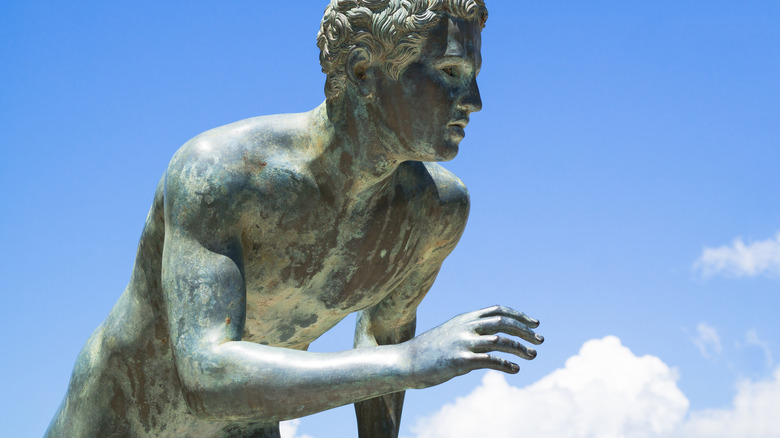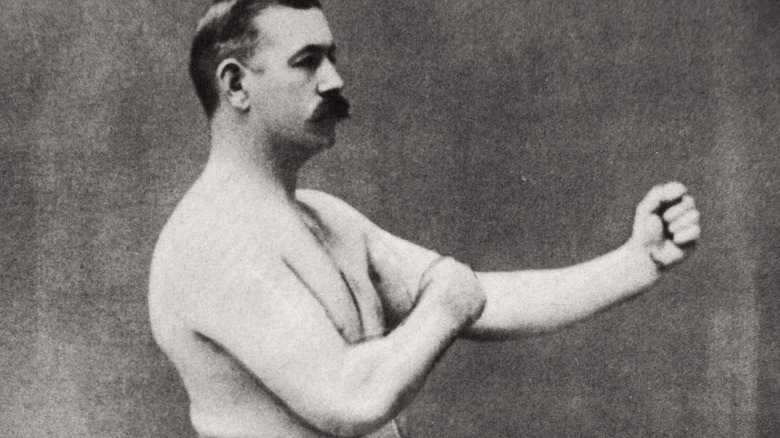The Surprising History Of Running Explained
Running is one of the most popular sports and exercise regimens in the world. According to data from Livestrong, 50 million Americans, or 15% of the population as a whole, runs or jogs. Of them, over 18 million registered for a race in the year 2018; and between the COVID-19 shutdown of gyms and new running technology like Strava and Fitbit, this figure seems set to rise.
Running is a strange sport; it's so intuitive that children do it without prompting and so unexpected that to see someone running for a practical reason — because they're late for work, for instance — makes people gawk. Yet no one looks twice at the woman running in a circle for an hour every Sunday morning.
Running is now so ubiquitous it's easy to forget that not long ago, it was considered a niche sport or a weird hobby. As recently as 1968, the Chicago Tribune (quoted by Vox) published a piece about joggers that treated them like lunatics. Some of them, went the report, were mad enough to run an entire mile. (The marathon your sister is training for is 26.2 miles, but nevermind.)
Ancient origins
One thing to note about the Chicago Tribune's bemusement is that it only extended to jogging as recreation. Running as a sport, or as conditioning for sport, had a long history, quite familiar even to reporters who saw "folly in the sight of a grown man running" on city streets.
Running is a primitive activity, like wrestling or throwing, and we've likely been running for fun for longer than written history can record. The indigenous Tarahumara people of Mexico famously run hundreds of miles in sandals (per Runners World); in Peru, the Incan Empire relied on relay runners called chasqui, who would sprint with news and supplies for a kilometer or two along mountain trails (via ThoughtCo). But the notion of running as a formal game is most closely associated with ancient Greece. Competitors at the early Olympic Games, for example, ran 200-meter races, either naked or in soldier's armor.
In fact, the Greeks were running long before the Olympics. In the Iliad, Achilles hosts a series of ceremonial games in honor of his dead friend Patroclus, which include a footrace. The Iliad commonly refers to Achilles and other heroes as "swift-running."
Boxing and public schools
Running had its place in exercise routines in the centuries that followed, but it's not clear how far people were running, or how often. The French philosopher Montaigne recalled his own father, an unusually fit old man, using "shoes with leaden soles to make him lighter for running or leaping" (via Essays of Michel de Montaign).
But the rise of professional sport in the 1700s made running more popular and less niche. Boxers in particular began to run to gain an edge on their rivals in long fights. Bleacher Report quotes an 18th-century boxing magazine, Boxiana, as saying that a fighter "must rise at five in the morning, run half a mile at top speed uphill and walk six miles at a moderate pace ... Immediately after dinner he must resume his exercise by running half a mile at top speed, and walking six miles."
In the 19th century, pedestrianism, or competitive speed walking, was a popular spectator sport, with thousands crowding Madison Square Garden to watch and men huff and puff in a circle for days on end, without breaking contact with the ground (via NPR). At the same time, the Victorian ideal of "muscular Christianity" inspired English public schools to send their boys on long, cross-country runs, playing games like hares and hounds and inventing the modern sport of cross-country, per Runners World. By 1896, when the modern Olympic Games debuted, a marathon run of 26.2 miles and shorter track events made brought running for its own sake to a broad, international public.
Running for civilians
So when did athletes hand off the baton to your parents? According to Boston University, running as a hobby blew up in the 1970s. This was partly due to celebrity athletes in running disciplines, like Joan Benoit, who encouraged people to stay in shape. But mostly it was the work of Bill Bowerman, according to Vox, a track coach at the University of Oregon. Bowerman was a disciple of the infamous New Zealand middle-distance coach, Arthur Lydiard, whose massively high-volume training plans brought Oregon track to success.
Bowerman would go on to co-found Nike, the shoe manufacturer. Advertisement has an intense yet sometimes imperceptible effect on people's behavior; that was never truer than in the 1970s when the cult of the individual reached its self-absorbed modern peak. An attractive physique was a valuable commodity in the era of Studio 54; people started jogging, running shoes flew off the shelves, and a modern industry was born.



